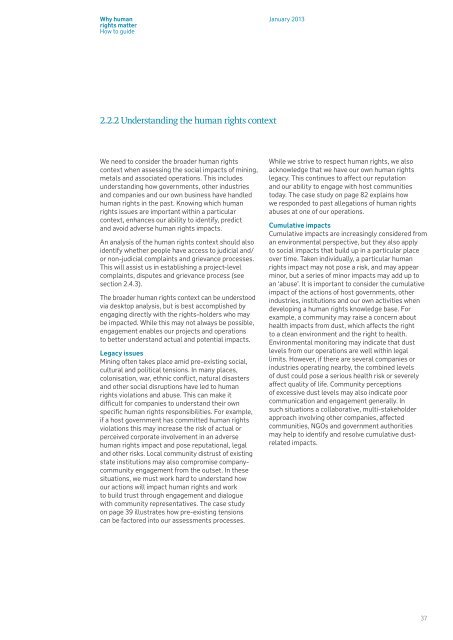Why human rights matter - Rio Tinto
Why human rights matter - Rio Tinto
Why human rights matter - Rio Tinto
You also want an ePaper? Increase the reach of your titles
YUMPU automatically turns print PDFs into web optimized ePapers that Google loves.
<strong>Why</strong> <strong>human</strong><br />
<strong>rights</strong> <strong>matter</strong><br />
How to guide<br />
January 2013<br />
2.2.2 Understanding the <strong>human</strong> <strong>rights</strong> context<br />
We need to consider the broader <strong>human</strong> <strong>rights</strong><br />
context when assessing the social impacts of mining,<br />
metals and associated operations. This includes<br />
understanding how governments, other industries<br />
and companies and our own business have handled<br />
<strong>human</strong> <strong>rights</strong> in the past. Knowing which <strong>human</strong><br />
<strong>rights</strong> issues are important within a particular<br />
context, enhances our ability to identify, predict<br />
and avoid adverse <strong>human</strong> <strong>rights</strong> impacts.<br />
An analysis of the <strong>human</strong> <strong>rights</strong> context should also<br />
identify whether people have access to judicial and/<br />
or non-judicial complaints and grievance processes.<br />
This will assist us in establishing a project-level<br />
complaints, disputes and grievance process (see<br />
section 2.4.3).<br />
The broader <strong>human</strong> <strong>rights</strong> context can be understood<br />
via desktop analysis, but is best accomplished by<br />
engaging directly with the <strong>rights</strong>-holders who may<br />
be impacted. While this may not always be possible,<br />
engagement enables our projects and operations<br />
to better understand actual and potential impacts.<br />
Legacy issues<br />
Mining often takes place amid pre-existing social,<br />
cultural and political tensions. In many places,<br />
colonisation, war, ethnic conflict, natural disasters<br />
and other social disruptions have led to <strong>human</strong><br />
<strong>rights</strong> violations and abuse. This can make it<br />
difficult for companies to understand their own<br />
specific <strong>human</strong> <strong>rights</strong> responsibilities. For example,<br />
if a host government has committed <strong>human</strong> <strong>rights</strong><br />
violations this may increase the risk of actual or<br />
perceived corporate involvement in an adverse<br />
<strong>human</strong> <strong>rights</strong> impact and pose reputational, legal<br />
and other risks. Local community distrust of existing<br />
state institutions may also compromise companycommunity<br />
engagement from the outset. In these<br />
situations, we must work hard to understand how<br />
our actions will impact <strong>human</strong> <strong>rights</strong> and work<br />
to build trust through engagement and dialogue<br />
with community representatives. The case study<br />
on page 39 illustrates how pre-existing tensions<br />
can be factored into our assessments processes.<br />
While we strive to respect <strong>human</strong> <strong>rights</strong>, we also<br />
acknowledge that we have our own <strong>human</strong> <strong>rights</strong><br />
legacy. This continues to affect our reputation<br />
and our ability to engage with host communities<br />
today. The case study on page 82 explains how<br />
we responded to past allegations of <strong>human</strong> <strong>rights</strong><br />
abuses at one of our operations.<br />
Cumulative impacts<br />
Cumulative impacts are increasingly considered from<br />
an environmental perspective, but they also apply<br />
to social impacts that build up in a particular place<br />
over time. Taken individually, a particular <strong>human</strong><br />
<strong>rights</strong> impact may not pose a risk, and may appear<br />
minor, but a series of minor impacts may add up to<br />
an ‘abuse’. It is important to consider the cumulative<br />
impact of the actions of host governments, other<br />
industries, institutions and our own activities when<br />
developing a <strong>human</strong> <strong>rights</strong> knowledge base. For<br />
example, a community may raise a concern about<br />
health impacts from dust, which affects the right<br />
to a clean environment and the right to health.<br />
Environmental monitoring may indicate that dust<br />
levels from our operations are well within legal<br />
limits. However, if there are several companies or<br />
industries operating nearby, the combined levels<br />
of dust could pose a serious health risk or severely<br />
affect quality of life. Community perceptions<br />
of excessive dust levels may also indicate poor<br />
communication and engagement generally. In<br />
such situations a collaborative, multi-stakeholder<br />
approach involving other companies, affected<br />
communities, NGOs and government authorities<br />
may help to identify and resolve cumulative dustrelated<br />
impacts.<br />
37
















![[PDF] Community Development Toolkit - CommDev](https://img.yumpu.com/48616495/1/184x260/pdf-community-development-toolkit-commdev.jpg?quality=85)
